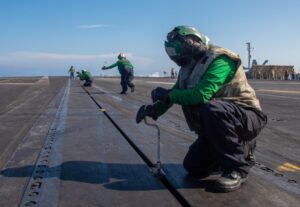
Aircraft Launch and Recovery Equipment (ALRE) Sailors man an arresting gear wire on the flight deck of USS Harry S. Truman (CVN 75) during a scheduled deployment.
Commander Naval Air Forces and Headquarters Marine Corps have brought a heightened awareness to Naval Aviation safety to prevent mishaps. In response, the Naval Aviation Enterprise has been improving safety management processes, tools and methods to be more data driven.
Several pilot programs are underway to test and mature these new approaches. One of the four pilots is spearheaded by the Aircraft Launch and Recovery Equipment (ALRE) Program Office (PMA-251).
PMA-251 executes the timely development, acquisition and sustainment of ALRE systems onboard all ships operating aircraft from their flight decks. PMA-251 is responsible for all systems and equipment used to launch and recover fixed and rotary-wing aircraft. For their pilot, PMA-251 has decided to focus on catapults and arresting gear that support Ford- and Nimitz-class carriers. These systems were selected due to their consequence of failure.
To launch the effort, PMA-251 pilot team members held a Class Desk Safety Review (CDSR) in July of 2023 and a System Safety Working Group (SSWG) meeting in August. These two working-level forums are part of a monthly safety drumbeat in the new governance structure designed to maintain progress on risk mitigation that delivers improved safety outcomes for the fleet. These forums also prioritize topics for quarterly Program Safety Review Boards (PSRBs), where resource and priority decisions are made.
CDSRs and SSWGs review recent mishaps; discuss close calls (also referred to as near misses), status progress of investigations and mitigation plans; evaluate safety data and look for trends—all to prevent mishaps.
“Our traditional steam-driven catapults and new electromagnetic system, along with the rest of the launch and recovery equipment, play heaviest in safety concerns and how the flight deck operates,” said CAPT Mike Kline, program manager, PMA-251.
Less than three months into the effort, results from incoming data sources for these commodities are different than those for an aircraft platform. Safety operations and other teams are gathering data to evaluate ALRE information. The team has discovered that valuable safety records of ALRE may reside in an aircraft hazard report, a maintenance record held by the Naval Sea Systems Command, or in the memory of a sailor assigned to the equipment. This kind of information disbursement has exposed areas for data storage and gathering improvement.
A pivotal component of this initiative is the alignment of safety protocols and communication. The program aims to fortify safety protocols and governance structures, driven by the imperative to curtail incidents that cause fatalities, injuries and asset losses.
The challenges of analyzing safety incidents span numerous key performance indicators, including system performance, personnel training, operational tempo and individual factors. Although the culture of safety has a positive record of documenting and reporting safety issues, the challenge is in determining the root cause or causes for each incident.
“While some parameters that can contribute to safety events may be unique, basic data challenges in safety governance are not,” said Kline. “Having the right data at the right time easily captured and efficiently extracted are common goals more easily stated than achieved. PMA-251 and other pilot programs are on a path to get closer to this desired operating model.”
Courtesy of Naval Aviation Enterprise (NAE) News.


